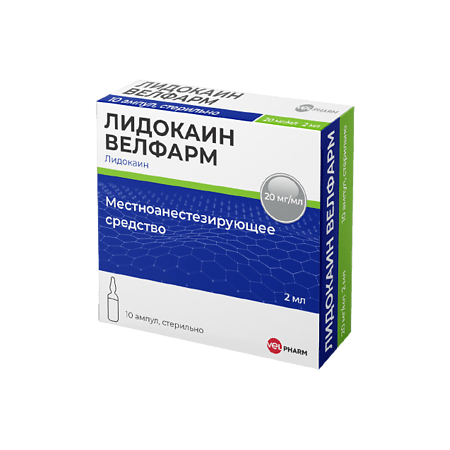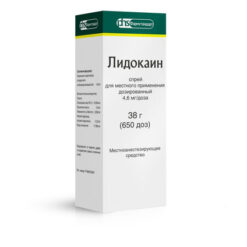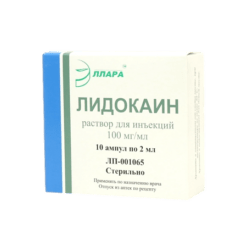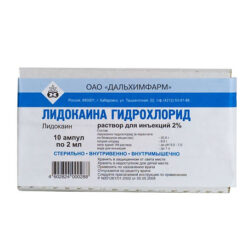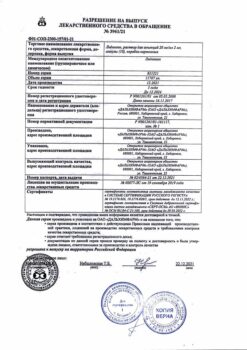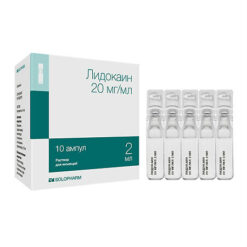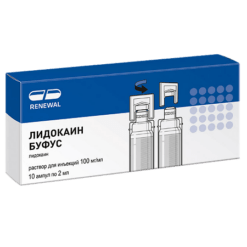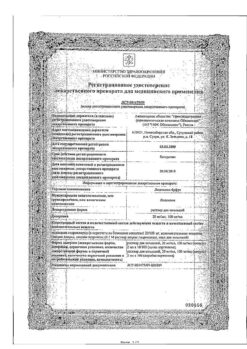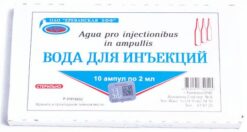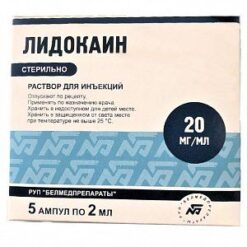No products in the cart.
Lidocaine Welfarm 20 mg/ml 2 ml, 10 pcs.
€1.00
Out of stock
(E-mail when Stock is available)
EAN: 4650099780398
SKU: 345092
Categories: Anesthesia and resuscitation, Local anesthetics, Medicine
Description
A class IB antiarrhythmic agent, local anesthetic, acetanilide derivative. It has membrane stabilizing activity. Causes blockade of sodium channels of excitable neuronal and cardiomyocyte membranes.
Leadoin decreases duration of action potential and effective refractory period in Purkinje fibers and suppresses their automatism. At the same time, lidocaine suppresses the electrical activity of depolarized, arrhythmogenic sites, but has minimal effect on the electrical activity of normal tissues. When used in medium therapeutic doses, it practically does not change myocardial contractility and does not slow down AV conduction. When administered as an antiarrhythmic agent when administered by injection, the onset of action in 45-90 seconds and its duration – 10-20 minutes; when administered by injection, the onset of action in 5-15 minutes and its duration – 60-90 minutes.
Causes all types of local anesthesia: terminal, infiltration, conduction.
Indications
Indications
Active ingredient
Active ingredient
Composition
Composition
How to take, the dosage
How to take, the dosage
As an antiarrhythmic agent in adults, when administered in a loading dose v/v – 1-2 mg/kg for 3-4 minutes; the average single dose is 80 mg. Then immediately switch to drip infusion at a rate of 20-55 mcg/kg/min. Drip infusion can be carried out for 24-36 hours. If necessary, against the background of the drip infusion, lidocaine can be repeated by intravenous jet injection at a dose of 40 mg 10 min after the first loading dose.
I/m is administered 2-4 mg/kg; if necessary, a second injection is possible after 60-90 min.
In children, when a loading dose is administered intravenously, 1 mg/kg; if necessary, a second administration after 5 minutes is possible. For continuous intravenous infusion (usually after a loading dose), 20-30 µg/kg/min.
For use in surgical and obstetric practice, dentistry, ENT practice the dosing regimen is established individually depending on the indication, the clinical situation and the dosage form used.
Maximum doses: in adults, when administered intravenously, a loading dose of 100 mg, followed by a drip infusion of 2 mg/min; when administered intravenously, 300 mg (about 4.5 mg/kg) for 1 hour.
In children, in case of repeated administration of a loading dose at 5-minute intervals, the total dose is 3 mg/kg; in continuous IV infusion (usually after administration of the loading dose), 50 µg/kg/min.
Interaction
Interaction
Concomitant use with barbiturates (including phenobarbital) may increase lidocaine metabolism in the liver, decrease blood plasma concentrations and, consequently, decrease its therapeutic effectiveness.
Concomitant use with beta-adrenoblockers (including propranololol, nadolol) may increase the effects of lidocaine (including toxic effects), probably due to delayed metabolism in the liver.
Concomitant use with MAO inhibitors may increase the local anesthetic effect of lidocaine.
Concomitant use with drugs causing neuromuscular transmission blockade (including suxamethonium chloride) may increase the effect of drugs causing neuromuscular transmission blockade.
Concomitant use with hypnotics and sedatives may increase CNS depressant effects; with aymalin, quinidine – possible increase in cardiodepressant effects; with amiodarone – there have been described cases of seizures and SSRIs.
Concomitant use with hexenal, sodium thiopental (IV) may cause respiratory depression.
Concomitant use with mexiletine increases lidocaine toxicity; with midazolam – moderate decrease in plasma lidocaine concentrations; with morphine – enhancement of the analgesic effect of morphine.
Cases of agitation and hallucinations have been described when concomitant use with procainamide.
Concomitant use with propafenone may increase the duration and severity of CNS side effects.
It is believed that under the influence of rifampicin, plasma concentrations of lidocaine may decrease.
An increased central side effect is possible with concomitant intravenous infusion of lidocaine and phenytoin; there has been a case of sinoatrial block due to the additive cardiodepressant effect of lidocaine and phenytoin.
In patients receiving phenytoin as anticonvulsant treatment, plasma concentrations of lidocaine may decrease due to induction of microsomal liver enzymes by phenytoin.
Concomitant use with cimetidine moderately decreases clearance of lidocaine and increases its plasma concentration, there is a risk of increased side effects of lidocaine.
Special Instructions
Special Instructions
Caution should be used in conditions accompanied by decreased hepatic blood flow (including chronic heart failure, liver diseases), progressive cardiovascular insufficiency (usually due to the development of heart block and shock), in severe and weakened patients, elderly patients (over 65 years); for epidural anesthesia – with neurological diseases, septicemia, inability to perform puncture due to spinal deformity; for subarachnoid anesthesia – for back pain, brain infection, benign and malignant brain tumors, coagulopathies of various genesis, migraine, subarachnoid hemorrhage, arterial hypertension, arterial hypotension, paresthesia, psychosis, hysteria, in noncontact patients, inability to perform puncture due to spinal deformation.
Lidocaine solutions should be used with caution in tissues with abundant vascularization (e.g., in the neck area for thyroid surgery); in these cases, lidocaine is used in lower doses.
Concomitant use with beta-adrenoblockers and with cimetidine requires reduction of the dose of lidocaine; with polymyxin B, respiratory function should be monitored.
Lidocaine parenterally should not be used during treatment with MAO inhibitors.
Injection solutions containing epinephrine and norepinephrine are not intended for intravenous administration.
Lidocaine should not be added to transfused blood.
Impact on driving and operating machinery
After using lidocaine, it is not recommended to engage in activities requiring high concentration and rapid psychomotor reactions.
Contraindications
Contraindications
For subarachnoid anesthesia – complete heart block, bleeding, arterial hypotension, shock, infection of the lumbar puncture site, septicemia.
High sensitivity to lidocaine and other local anesthetics of the amide type.
Side effects
Side effects
Similarities
Similarities
Additional information
| Manufacturer | Welfarm, Russia |
|---|---|
| Medication form | solution for injection |
| Brand | Welfarm |
Other forms…
Related products
Buy Lidocaine Welfarm 20 mg/ml 2 ml, 10 pcs. with delivery to USA, UK, Europe and over 120 other countries.

